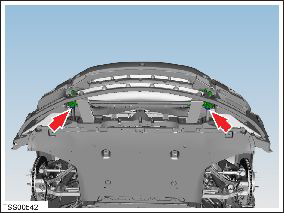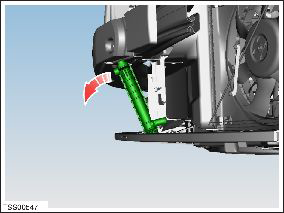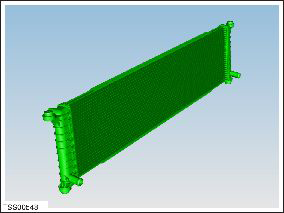Tesla Model S: Radiator (Remove and Replace)
Tesla Model S (2012-2025) Service Manual / Thermal Management / Radiator (Remove and Replace)
Removal
- Drain the cooling system (refer to procedure).
- Remove the front fascia assembly for access (refer to procedure).
- Release the clamps (x2) that secure the feed and return hoses to
the radiator. Release the hoses from the radiator.
Note: Place suitable absorbent material around the affected area to absorb any possible fluid spillage.

- Carefully release the clips (x2) that secure the front LH duct
to the rear duct. Repeat on the RH side.

- Carefully release the clips (x6) that secure the radiator front
duct lower fixings to the rear duct.

- Carefully release the clips (x6) that secure the radiator front
duct upper fixings to the rear duct.

- Remove the radiator front duct.
- Release the radiator from the upper mounting brackets (x2).
Caution: Be careful not to damage the radiator during this procedure.

- Maneuver the top of the radiator forwards and lift up the bottom
to clear the ankle catcher.
Note: If necessary, remove the ankle catcher (refer to procedure).

- Remove the radiator.

- Installation procedure is the reverse of removal, except for the following:
- Refill and bleed the cooling system (refer to procedure).
READ NEXT:
 Reservoir Assembly - Coolant (Remove and Replace)
Reservoir Assembly - Coolant (Remove and Replace)
Warning: If the 12V power supply is disconnected, do
not attempt to open any doors with door glass in closed position.
Failure to follow this instruction could result in door glass
shat
 Reservoir Assembly - Coolant (Dual Motor) (Remove and Replace)
Reservoir Assembly - Coolant (Dual Motor) (Remove and Replace)
Warning: If the 12V power supply is disconnected, do
not attempt to open any doors with door glass in closed position.
Failure to follow this instruction could result in door glass
shat
 Reservoir Cap - Coolant (Remove and Replace)
Reservoir Cap - Coolant (Remove and Replace)
Removal
Remove the rear underhood apron (refer to procedure).
Remove the cap from the reservoir.
Installation
Ins
SEE MORE:
 Overview of Steering Yoke Buttons
Overview of Steering Yoke Buttons
Your Model S features stalkless driving in which all
controls you need when driving are accessible on the
steering yoke.
Right turn signal
High beam headlights*
Left turn signal
Left scroll button
Horn
Identifier that is always illuminated to indicate that
the right scroll wheel can be
 Climate Popup
Climate Popup
Touch the temperature arrows on the bottom of the touchscreen to display a
popup for easy access to some of the
most common climate controls:
NOTE: For one-touch access to seat heaters and defrosters, you can add
these controls to My Apps. See
Customizing My Apps.
Touch to access the main cli
© 2019-2025 Copyright www.tesms.org

